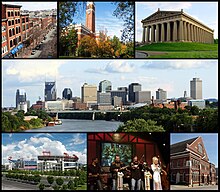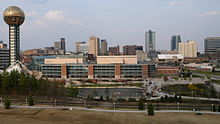List of metropolitan areas of Tennessee
Appearance
This article needs additional citations for verification. (October 2024) |
Metropolitan Statistical Areas are, according to the University of Tennessee Knoxville as areas "centered around counties containing a census-defined urban area with a population of 50,000 or more."[1]




| Rank | Metropolitan area | Population 2019 estimates |
|---|---|---|
| 1 | Nashville | 1,982,264 |
| 2 | Memphis | 1,324,926 |
| 3 | Knoxville | 869,046 |
| 4 | Chattanooga | 547,303 |
| 5 | Kingsport–Bristol–Bristol | 305,629 |
| 6 | Clarksville | 268,546 |
| 7 | Johnson City | 197,381 |
| 8 | Morristown | 137,612 |
| 9 | Jackson | 113,629 |
| 10 | Cleveland | 113,358 |
| 5,246,895 |
| Rank | Combined statistical area | Population 2009 estimates |
|---|---|---|
| 1 | Nashville-Davidson–Murfreesboro–Columbia | 1,666,566 |
| 2 | Knoxville-Morristown-Sevierville-La Follette | 1,053,627 |
| 3 | Chattanooga-Cleveland-Athens | 690,400 |
| 4 | Johnson City-Kingsport-Bristol | 503,010 |
| 5 | Jackson-Humboldt | 163,097 |
| 6 | Martin-Union City | 71,704 |
See also
[edit]- Table of United States Metropolitan Statistical Areas
- Table of United States Combined Statistical Areas
References
[edit]- ^ "New Metropolitan and Micropolitan Area Boundaries Include Changes for Eight Tennessee Counties". Tennessee State Data Center. 2023-08-21. Retrieved 2024-10-16.
